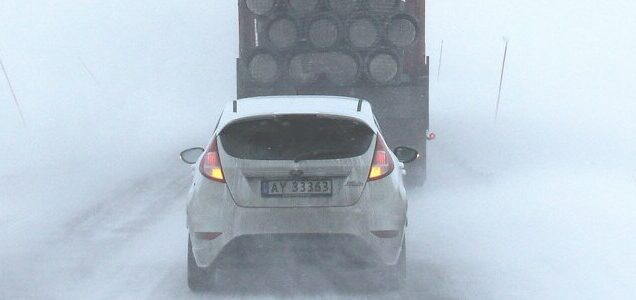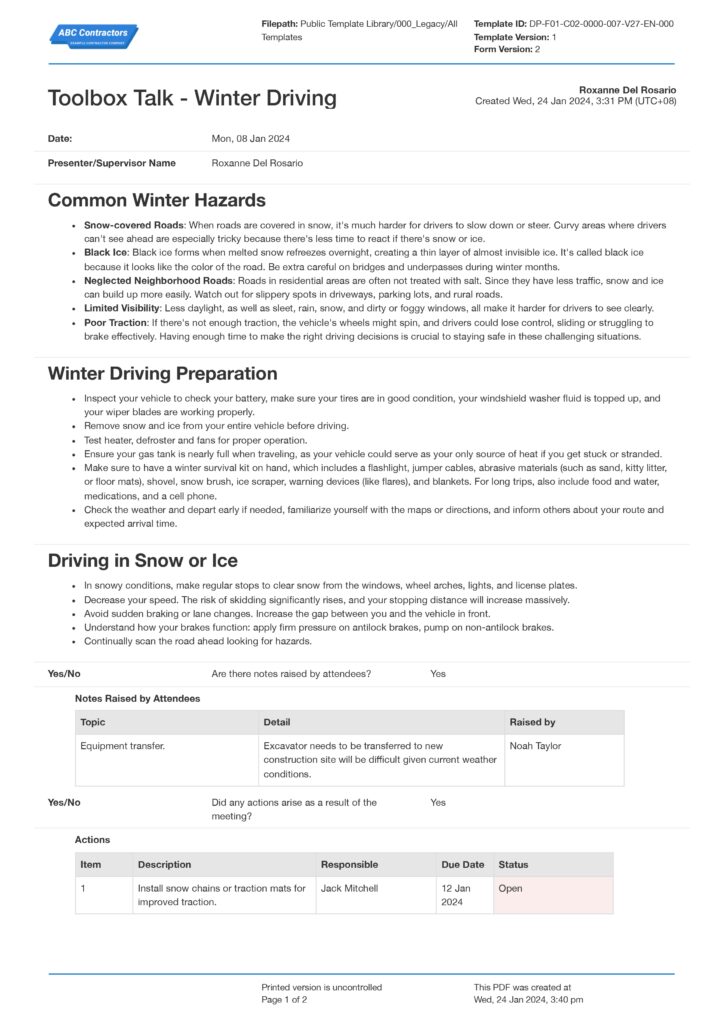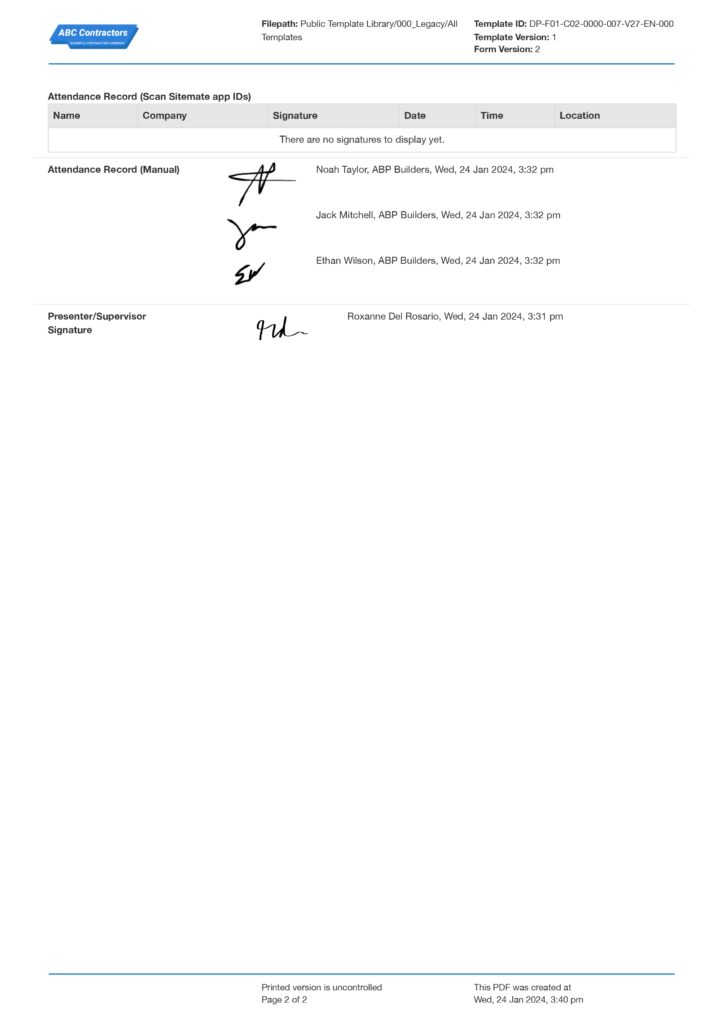Dashpivot Article – Safety Moment Winter Driving
Safety Moment Winter Driving
In this article, we will be navigating topics for your safety moments when driving during winter to maintain a safe journey through the snowy path.

Importance of Safety Moments for Winter Driving
For a season that is mostly associated with Christmas, winter truly is a magical and beautiful time for everyone. The white blankets on trees lit with warm lights, different Christmas carols being played in different stores, and the cosiness brought by the cold weather—winter really brings us back to that familiar feeling when we were children whenever the snow starts to fall. This supposed chilly season turned warm by the joyous events associated with it. However, winter conceals its dangers behind the façade of Christmas carols and hot cocoa, despite being a season to look forward to.
There are multiple hazards associated with this season, especially when driving. Being a very busy season, driving on ice-covered roads can become hazardous for those delivering goods for people to buy and bring to their homes. Furthermore, there are a number of different industries that still need to operate, which vehicles can be a part of their processes. It is important that safety measures for being on the road during winter should be discussed formally. The best avenue to conduct such discussions is in safety moment meetings. Having a safety moment about winter driving can educate or remind workers on the safety steps to do before, during, and after driving during winter.
Safety Moment Topics on Winter Driving
We have already discussed that while winter is a beautiful season, it brings hazards that can be dangerous for drivers navigating through the winter wonderland. To provide your workers with knowledge on the safety measures and safety steps when driving during winter, a safety moments meeting must be conducted to formally inculcate this vital information into them. At this part of the article, we will be discussing different safety moment topics related to winter driving safety. We will explain why these topics are relevant and how the knowledge of this topic can help build a safety culture around winter driving.
Vehicle Inspection
A vehicle inspection is a preventive maintenance tactic and procedure that thoroughly checks the vehicle for minor to major damages. This procedure helps identify if the vehicle can be optimally operated when drivers start running the car, driving the car, and parking the car for the day. In this subsection, we will talk about the 3 different modes of inspection when driving. Discussing these three modes can be more crucial during winter since there are parts of the cars that need to be replaced during the winter season.
Here are the three modes of inspection for vehicles:
-
Pre-drive Inspection: Pre-drive inspection refers to the inspection being done before driving the vehicle. This thoroughly checks if all the parts important for driving are functioning properly and are not damaged. Pre-drive inspections can also be a confirmatory check if the parts of the car are the correct parts. This is especially crucial for seasonal vehicle parts. During winter it is essential to check if the vehicle has already switched to winter tyres, winter-grade oils, winter-specific wiper blades, and provision of antifreeze in the coolant. All of these are necessary for safe driving during winter and should be checked if they are already installed.
-
Peri-drive Inspection: This refers to the inspection done on the vehicle when driving. This inspection does not necessarily mean that the driver should stop every now and then to check if the vehicle is still operational and to check if there are no damaged parts, but it means that motorists should stay vigilant and get a feel of the vehicle that they are driving. If they feel that there is something off with the car when driving, they should trust their instincts to stop the car and check the problem. Winter can usually cause the vehicle engine to malfunction, which affects the driving performance of the car. With this said, it is important that drivers are also well experienced to know well enough if there’s something wrong with a vehicle just by driving.
-
Post-drive Inspection: This refers to the inspection done after using the vehicle. Like the pre-drive inspection, this will be a thorough check on the car parts to see if there is any damage. Any inspected damage will then be reported and then placed for maintenance. Here is an example to illustrate the process. Let’s imagine a bucket truck being used the whole day for some wire change on poles. After the work, the operator of the truck uses his bucket truck inspection checklist to see if there are any damaged parts, which resulted from the day's work. Upon navigating through the inspection, the operator found out that the gasket on the hydraulic arm was leaking oil; therefore, he made a report of what he found and scheduled the truck for maintenance. Doing what he did negated the possibility of hydraulic failure, which can pose a lot of hazards if it isn’t addressed.
Vehicle Winter Parts
Vehicles, being non-living things (obviously), don’t have the ability to change themselves (yet) to adapt to the changes in winter. They require human intervention to replace their parts to be able to be fully operable during the cold season. One of these parts that needs to be replaced this season is the wheels. Winter wheels are designed to have better grip, have deeper grooves to channel snow, and have superior traction for braking. Using normal wheels during winter could prove to be dangerous since it is more prone to skidding and losing control in areas with black ice. It is important to discuss this need for change of parts of the vehicle during winter in your team to provide awareness and instill responsibility in the operators.
Winter Road Hazards
Recognising the hazards is the first step to being able to effectively implement the required safety measures when driving in the winter. Having said that, companies should provide all vehicle users awareness of all the hazards on the road. One of the hazards that drivers should look out for is black ice. Black ice is a thin, translucent layer of frozen water on the road. It is a real menace since it is transparent and blends in with road pavements, making it impossible for drivers to know of their presence. These roads with black ice are so slippery that they have the potential to make vehicles lose control when speeding over them. Black ice is only one of the hazards that can be found during winter. It is important to provide winter driving safety tips that help build safety practices and let drivers be fully responsible in placing safety measures that shield them against the hazards of driving during winter.
Defensive Driving
The term "defensive driving" refers to a collection of skills and practices that teach drivers how to anticipate and react to possible dangers that may be encountered on the road. It requires you to be aware of your surroundings, to keep your attention, and to be ready to respond rapidly to events that you did not anticipate. The objective of defensive driving is to lessen the likelihood of being involved in an accident by using safe driving practices. These strategies include maintaining a safe distance from other cars, adhering to traffic rules, and modifying driving behaviour to consider the conditions of the road and the weather.
Weather Awareness
Winter weather can be very unpredictable. One moment it's just the chilly and freezing air; the next moment heavy snow could be falling from the sky. Now, because of the effects of climate change, the unpredictability of winter weather has become more erratic. Having said this, road conditions are highly affected, which makes driving more hazardous. In your safety moments meeting, you could discuss procedures on how to go about driving when placed in certain winter weather conditions like heavy snowstorms, hail, frost, sleet, and blizzards. Having an established procedure on these conditions can provide guidelines on the proper safety steps and measures to keep the driver shielded from such harsh conditions. Also, being constantly updated on the news about the weather can help drivers be prepared.

Use this free Safety Moments format for free
A Digital Approach to Safety Moment Talks and Ideas
A safety moment is a great platform to talk about safety and health in the workplace. Making a safety moment by hand, however, might be a bit time-consuming. The constant printing and reformatting can be a little frustrating if it is done more often. Additionally, making these forms by the pen-and-paper method requires you to open a lot of computer applications to make a form and record the contents of the form. This consumes a lot of time and is highly prone to human error.
With the Dashpivot Safety Moment App, you can use a digital form, which you can create using a sophisticated form builder, or simply choose a pre-made form from one of the app template library's free safety moment idea templates. You may also use the digital file without worrying about the internet. While on the field, you can use the Safety Moment Talk app while offline. Once you have supplied the necessary data from your meetings, you can just save the file and upload it later when the internet is available.
Any completed or pre-made safety moment meetings may also be easily located, updated, or converted into a professionally created PDF document online, where they are automatically structured and kept.
To do all of these and more, use the Dashpivot safety moment app. For further information, click this link: The Dashpivot app for Safety Moment.

Safety Violation
This safety violation template makes it easy to produce and share professional safety violation notices and reports.

Safe Work Method Statement for Driving/Transportation
Ensure your workers and projects are referencing a good safe work method statement when driving - not bad habits

Truck Driver Safety Checklist
Make your truck driver safety checklists more accessible and more compliant using a digital template.

